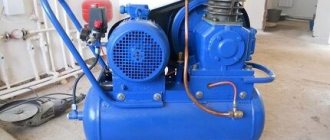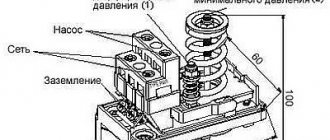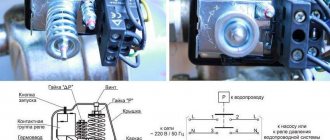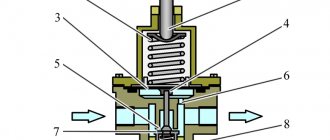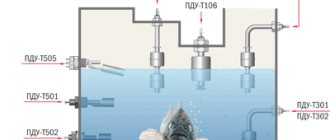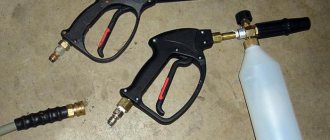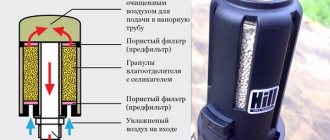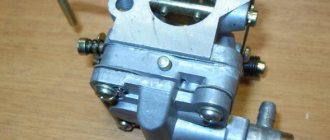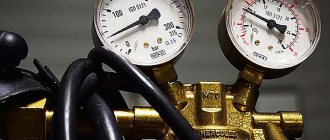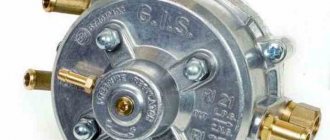The name of the relay is determined by its purpose - controlling a piston compressor to maintain the required atmospheric pressure in the receiver. It is rarely found on a screw type device responsible for compressing and supplying air.
If you are planning to purchase a pressure switch for your compressor, then you have come to the right place. Here you will find a vast amount of extremely useful information about the principles of operation of the device, its configuration and connection methods.
The author of the article describes in detail the existing types of pneumatic relays. Provides options for connecting to household and industrial networks with extremely clear diagrams. Discusses typical breakdowns and ways to prevent them. The information and useful tips presented to you are complemented by graphic, photo and video applications.
Operating principle of a pressure switch
I take into account the magnitude of the pressing force in pneumatic automation; the device acts on the voltage line, closing or opening it. Thus, insufficient pressure in the compressor starts the motor, and when the required level is reached, it turns it off.
This standard operating principle, based on connecting a normal closed loop to a circuit, is used to control the motor.
The design of all ejectors contains a cylinder containing air at a certain pressure. Reducing it requires turning on the engine to replenish the supply. If the situation is the opposite and an excess is detected, the supply is stopped so that the container does not burst. These processes are controlled by a pressure switch
Modifications with the opposite operating algorithm are also presented: when reaching minimum values in the compression circuit, the pressure switch turns off the electric motor, and at maximum values it activates. Here the system operates in a normally open loop.
The operating system is made up of spring mechanisms with varying degrees of rigidity, reproducing the response to fluctuations in the air pressure unit.
During operation, the indicators formed as a result of the elastic force of tension or compression of the springs and the pressure of the atmosphere pressed by the device are compared.
Any changes automatically activate the action of the spiral and the relay unit connects or disconnects the electricity supply line.
However, it is worth considering that the design of the review model does not provide for regulatory influence. Exceptional impact on the engine. In this case, the user has the opportunity to set a peak value, upon reaching which the spring will fire.
Purpose
After the compressor engine starts, the pressure in the receiver begins to increase.
If the excitation rheostat slider R is moved, then a resistor will be introduced into the SHOV winding circuit. The presence of a free connector allows you to install the control pressure gauge in a place convenient for the user. Control the pressure using the pressure gauge and set the required values.
Other names are telepressostat and pressostat. To do this you will have to: Disconnect the wiring from the contacts; Cut through the motor tubes connecting it to other parts; Image 4 - biting the motor tube Unscrew the mounting bolts and remove from the casing; Disconnect the relay by unscrewing the screws; Image 5 - disconnecting the relay Next, you need to measure the resistance between the contacts; By applying the tester probes to the output contacts, normally you should get OM depending on the model of the engine and refrigerator. The working system consists of springs of different levels of rigidity that respond to changes in pressure.
There may also be other auxiliary mechanisms that require activation: a safety or unloading valve. Types of pressure switch devices There are only two variations in the design of the automatic compressor unit. With the help of a relay, it becomes possible to operate automatically while maintaining the required compression level in the receiver.
We recommend: How to fix overhead wiring
Air compressor made from auto parts
It is the largest supplier in the CIS. Scheme of automated control of an electric compressor The second contact PB1 turns on the signal relay P2 after 15 s; its closed contact can trigger an alarm, but by this time the pump mounted on the compressor manages to create the required pressure in the lubrication system, and the oil pressure switch RDM opens, interrupting alarm circuit. Control circuit for the electric drive of the fire-ballast pump When power is supplied to the circuit, even before the engine starts operating, the electromagnetic time relays RU1, RU2, RU3 acceleration relays are activated. This indicator must be less than the nominal pressure of the air blower.
Typically, the difference value is set to 1 bar. If the relay malfunctions and the compression level in the receiver rises to critical values, then in order to avoid an accident, the safety valve will operate, releasing the air.
Restarting with the KnP button is possible when contact Rв in its circuit is closed, which corresponds to the position of the Rв slider on the right. The operating system is made up of spring mechanisms with varying degrees of rigidity, reproducing the response to fluctuations in the air pressure unit.
If the pressure switch was found to be the source of the malfunction, the professional will insist on replacing the device. In addition, the pressure drop in the system will be significant. Install a control pressure gauge if it is not necessary, then the threaded inlet is also plugged. Compressor cannot gain speed REPAIR bad start FORTE VFL-50
Complete set of compressor automation unit
The relay design is a small-sized block equipped with receiving pipes, a sensing element (spring) and a membrane.
Mandatory subassemblies include an unloading valve and a mechanical switch.
The pressure switch sensing unit is made up of a spring mechanism, the compression force of which is changed by a screw.
According to the factory standardized settings, the elasticity coefficient is set to a pressure in the pneumatic chain of 4-6 at, as reported in the instructions for the device.
Inexpensive models of ejectors are not always equipped with relay automation since such devices are mounted on the receiver. However, during long-term operation, to eliminate the problem of overheating of engine elements, it makes sense to install a telepressostat
The degree of rigidity and flexibility of the spring elements is subject to the temperature of the environment, therefore absolutely all models of industrial devices are designed for stable operation in an environment from -5 to +80 ºC.
The reservoir membrane is connected to the relay switch. During movement, it turns the pressure switch on and off.
The unloading unit is connected to the air supply line, which allows excess pressure to be released into the atmosphere from the piston compartment. This relieves the moving parts of the compressor from excessive force.
The unloading element is located between the ejector check valve and the compression block. If the motor drive stops working, the unloading section is activated, through which excess pressure (up to 2 atm) is released from the piston compartment.
With further start or acceleration of the electric motor, a pressure is created that closes the valve. This prevents overloading of the drive and simplifies starting the device in switched off mode.
There is an unloading system with a time interval of activation. The mechanism remains in the open position when the engine starts for a specified period. This range is enough for the engine to achieve maximum torque.
A mechanical switch is required to start and stop the automatic system options. As a rule, it has two positions: “on.” and "off".
The first mode turns on the drive and the compressor operates according to the established automatic principle. The second one prevents accidental starting of the engine, even when the pressure in the pneumatic system is low.
Shut-off valves allow you to avoid emergency situations when elements of the control circuit fail, for example, a breakdown of the piston unit or a sudden stop of the motor
Safety in industrial structures must be at a high level. For these purposes, the compressor regulator is equipped with a safety valve. This ensures system protection in case of incorrect relay operation.
In emergency situations, when the pressure level is higher than the permissible norm, and the telepressostat does not work, the safety unit comes into operation and vents the air.
Optionally, a thermal relay can be used as additional protective equipment in the review device. With its help, the strength of the supply current is monitored for timely disconnection from the network when parameters increase.
To avoid burnout of the motor windings, the power is turned off. The nominal values are set using a special control device.
Conclusions and useful video on the topic
Details about the design of the pressure switch, as well as a visual process for adjusting its parameters in the plot:
It is also possible to independently assemble the control unit for the compressor; see this video:
Pneumatic devices are considered safer and easier to use than electric or gasoline models. There is a wide selection of additional equipment that works with compressed air: guns for washing, inflating tires or painting and many others.
With the help of a relay, it becomes possible to operate automatically while maintaining the required compression level in the receiver.
Budget models of air compressors are not always equipped with a pressure switch, since similar devices are installed on the receiver. Therefore, manufacturers of this equipment believe that visual monitoring of the pressure developed by the compressor based on pressure gauge readings is quite sufficient. At the same time, during long-term work, in order to avoid engine overheating, it is advisable to install a pressure switch on the compressor. Then the drive will turn on and off automatically.
Types of pressure switch devices
There are only two variations in the design of the automatic compressor unit. The determination is made based on their operating principle.
In the first version, the mechanism turns off the electric motor when the established limits of the air mass pressure level in the pneumatic network are exceeded. These devices are called normally open.
Schematic structure of a membrane pressure switch: 1 – pressure converter; 2 and 3 – contacts; 4 – piston; 5 – spring; 6 – membrane; 7 – threaded connection
Another model with the opposite principle - turns on the engine if a drop in pressure is detected below the permissible level. Devices of this type are called normally closed.
How to connect without a capacitor
The classic condenser in refrigeration equipment is used to cool and convert gaseous refrigerant into the liquid phase. The refrigerant pump allows short-term operation without a condensing unit, but long-term operation of the unit is not recommended (due to lack of oil supply). There is an electrolytic capacitor in the compressor itself, which provides an additional current pulse at the moment the equipment starts up. The capacitor was used in refrigerators produced in the 60s and 70s. last century.
The capacitor works in conjunction with the control relay and is placed in the gap between the power line and the starting winding. When checking the performance of the motor, you can connect the power directly, bypassing additional circuit components. In equipment manufactured after the 90s, the element is not used. The capacitor is used to start 3-phase electric motors connected to a household AC network. The installed element simulates the missing phase, but such motors are not used in household refrigeration equipment.
If there was a capacitor in the circuit, then it is removed (soldered off), and subsequent start-up is carried out through a standard relay.
If the motor does not respond to power supply, then you will need to remove the relay. If, when power is applied, a monotonous hum is heard from the compressor housing, then the cause of the breakdown is jammed rolling bearings or a broken piston pump. If the motor does not work and there is no extraneous hum, then the cause of the loss of performance should be sought in a broken wire inside the compressor. Such a unit cannot be repaired, but must be disposed of.
Structure of pneumatic relay symbols
The marking of the air pressure switch indicates the entire optional set of the device, design features, including information about the factory settings for the pressure differential.
Condor's production models offer a wide range of pressure control equipment. The MDR series is aimed at using ejectors of various powers
Let us examine the designations in more detail using the example of devices for air ejectors RDK – (*) (****) – (*)/(*):
- RDK – series of relays for compressors;
- (*) – number of threaded ports: 1 – one port with 1/4”NPT internal thread; 4 – four connectors;
- (****) - type of housing design: T10P - version 10 with a “lever” switch; T10K – “button” switch; T18P – execution 18 with a “switch” switch; T19P - 19 s;
- (*) – factory settings of the threshold response: 1 – 4…6 bar; 2 – 6…8 bar; 3 – 8…10 bar;
- (*) – diameter of the unloading valve: the absence of a symbol means a standardized parameter of 6 mm; 6.5 mm – 6.5 mm.
The difference between the minimum and maximum pressure thresholds is set by the manufacturer and, as a rule, has a value of 2 bar.
However, it is also possible to manually adjust the range of two values – maximum and minimum, but only downward.
Air relay connection diagrams
The compressor pressure switch is manufactured for connection to electrical circuits of different loads. In accordance with the rating of the power supply line, the appropriate model of the relay unit is selected.
Option #1: to a network with a nominal value of 220 V
If the drive motor is a single-phase device, then a 220 V relay with two groups of contacts is installed.
To work with a single-phase load, manufacturers recommend equipping the unit using models of the RDK series: xT10R-x; xT10K-x; xT19P-x, since these devices have two contact groups
Option #2: to a three-phase network with a voltage of 380 V
For a three-phase load of a 380 V circuit, one of the options can be used: a modification of the relay for 220 V or 380 V, with three contact lines, to simultaneously disconnect all three phases.
Both methods have different schemes. Let's consider the first option:
To operate in a three-phase electrical circuit, a pressure switch RDK-xT18P-x is used. This model is equipped with three contacts and facilitates simultaneous switching of all phases
By choosing the second method, power is supplied from one phase (zero) and in this case the relay rating should be 220 V. For more details, see the following diagram:
It is allowed to use telepressostats of the RDK series: xT10R-x, xT10K-x and xT19P-x with a three-phase load, however, the use of such a circuit requires incomplete disconnection from the supply network. More specifically, one phase will be permanently connected to the load
After connecting to the power supply, you need to understand the additional capabilities provided in the air blocks for ejectors.
Diagrams for connecting the pressure switch to the compressor
The connection of the relay that controls the degree of air compression can be divided into 2 parts: the electrical connection of the relay to the unit and the connection of the relay to the compressor through the connecting flanges. Depending on which motor is installed in the compressor, 220 V or 380 V, there are different connection diagrams for the pressure switch. I am guided by these diagrams, provided that you have certain knowledge in electrical engineering, you can connect this relay with your own hands.
Connecting the relay to a 380 V network
To connect the automation to a compressor operating from a 380 V network, use a magnetic starter. Below is a diagram of connecting automation to three phases.
In the diagram, the circuit breaker is indicated by the letters “AB”, and the magnetic starter by “KM”. From this diagram it can be understood that the relay is set to a switch-on pressure of 3 atm. and shutdown - 10 atm.
Connecting the pressure switch to a 220 V network
The relay is connected to a single-phase network according to the diagrams given below.
These diagrams indicate various models of pressure switches of the RDK series, which can be connected in this way to the electrical part of the compressor.
Advice! Under the pressure cover there are 2 rows of terminals. Usually next to them there is the inscription “Motor” or “Line”, which, respectively, indicate contacts for connecting the motor and the electrical network.
Connecting the pressure switch to the unit
Connecting a pressure switch to a compressor is quite simple.
- Screw the pressure switch onto the receiver pipe using its central threaded hole. For better thread sealing, it is recommended to use fum tape or liquid sealant. The relay can also be connected to the receiver through a reducer.
- Connect a relief valve to the smallest output from the relay, if present.
- The remaining outputs from the relay can be connected to either a pressure gauge or a safety relief valve. The latter is installed without fail. If a pressure gauge is not required, then the free output of the pressure switch must be plugged with a metal plug.
- Next, wires from the electrical network and from the engine are connected to the sensor contacts.
After the complete connection of the pressure switch is completed, it is necessary to configure it for proper operation.
Installation of relays and auxiliary elements
In some modifications of pressure switches, you can find additional equipment in the form of flange connections, through which additional equipment is connected.
These are basically three-way parts, with a ¼-inch diameter.
By means of several flange connectors, additional elements can be introduced into the system: safety valve, pressure gauge and other necessary mechanisms
To put the device into operation, it must be connected to the receiver. Installation consists of the following steps:
- The device is connected to the compressor through the main outlet.
- A pressure gauge is connected to the device with flanges. There may also be other auxiliary mechanisms that require activation: a safety or unloading valve.
- Channels that are not used for connection must be closed with plugs.
- Next, according to the electrical diagram, the relay is connected to the contacts of the motor control circuit.
Motors with low power can be connected directly; in other cases, additional installation of an electromagnetic starter of appropriate power is required.
Before moving on to setting the threshold response parameters, it is worth paying attention to the operating conditions.
First, adjustments are made under pressure. Secondly, the electrical supply to the engine must be cut off.
Connection diagram
The connection diagram for the pressure switch depends on the type of electric motor. Single-phase ones are controlled by relays designed for 220 V with two contact groups. For three-phase electric motors, a 380 V device is installed, with three contact groups, each connecting its own phase. The use of single-phase switches for three-phase loads is unacceptable, since one of the phases remains permanently connected to the winding.
Flange connections
A number of manufacturers install additional flange connectors on their products. Most often there are two or three of them, the standard size is ¼ “. Through them, components such as a safety valve, pressure gauge, etc. are connected.
Installing a pressure switch
For installation, you must perform the following operations:
- Connect the relay to the receiver pipe.
- Connect the pressure gauge, safety and relief valves through the flange connectors.
- Place plugs in the remaining unoccupied connectors.
- Connect the wires from the engine to the electrical connector of the device.
- Make adjustments.
The last point should be considered in more detail.
Relay adjustment
Important! The adjustment is carried out with at least 2/3 of the tank filled and the power turned off. The manufacturer supplies devices that have been tested and adjusted to standard values. If the parameters of a given compressor or the characteristics of consumer devices require the relay to be adjusted to other values, the following should be done:
The manufacturer supplies devices that have been tested and adjusted to standard values. If the parameters of a given compressor or the characteristics of consumer devices require the relay to be adjusted to other values, the following should be done:
- Remove the device cover.
- Two wrench heads will become visible.
- The big one controls the shutdown pressure and is designated by the letter P (Pressure).
- The small one controls the pressure difference at which the motor turns on. It is designated by the letters ΔP.
- The arrows indicate the direction of rotation for increasing values (+) and decreasing values (-).
- Control the pressure using the pressure gauge and set the required values.
Next, you should reassemble the device in reverse order. The compressor is ready for operation.
Source
Compressor adjustment and commissioning process
Factory set parameters do not always meet consumer requirements. In most cases, this is due to insufficient compression force at the highest point of disassembly.
The operating range of the pressure switch may also not be suitable. In this case, independent adjustment of the actuator will be relevant.
Standard factory settings: upper limit 2.8 atmospheres, lower limit 1.4 bar. The parameters are monitored visually using a pressure gauge included in the standard pressure switch kit. New models, for example, Italtecnica, have a transparent body and are equipped with a compression scale indicator directly on the relay
To begin setting the operating compression value, you will need to inspect the engraved plate, which indicates the parameters of the electric motor and compressor.
We only need the largest value that the device produces. This indicator indicates the maximum pressure force that can be set on the relay for the correct operation of the entire pneumatic system.
If you set the specified value (in the figure 4.2 atm), then taking into account all factors - differences in power supply, exhaustion of the service life of parts, etc. - the compressor may not reach the maximum pressure, and accordingly it will not turn off.
In this mode, the working elements of the equipment will begin to overheat, then deform and eventually melt.
The maximum ejector value must be taken into account when determining the maximum relay value. This indicator should be less than the rated pressure of the compressor. In this case, all elements of the system will work uninterruptedly
For reliable operation without shutdowns, it is necessary to set the highest shutdown pressure on the relay, which does not reach the nominal value engraved on the compressor, namely 0.4-0.5 atm lower. According to our example - 3.7-3.8 atm.
The pressure limits at which the compressor is turned on/off are regulated by a single bolt. In order not to make a mistake with the choice of direction for increasing/decreasing, arrows are placed on the metal base
Having determined the level that will be set, it is necessary to remove the relay housing. Under it there are two adjusting elements - a small and a large nut (in Figure 1.3).
Nearby there are arrow indicators for the direction in which the twists will be made - thereby compressing and unclenching the spring mechanism (2.4).
A large screw clamp and spring are provided to control compression settings. When twisted clockwise, the spiral compresses - the compressor switch-off pressure increases.
Reverse adjustment - weakens, and accordingly, the pressure level for shutdown decreases.
It is worth remembering: by increasing the shutdown compression strength, we are changing the factory settings, which were set taking into account the regulatory requirements for the operation of the equipment. Before making adjustments, check the technical documentation of the device so as not to exceed the limits stated by the manufacturer
When reproducing settings, the receiver must be at least 2/3 full. Having understood the purpose of the elements, let's proceed:
- To ensure the proper level of safety, we turn off the power supply.
- Changing the compression level of the springs is done by turning the nut several turns in the required direction. On the board, near the large-diameter adjusting screw, according to the standards, there is a symbol in Latin letters P (Pressure), a smaller one - ΔР.
- The adjustment process is monitored visually on a pressure gauge.
For convenience, some manufacturers place the adjusting fittings for changing the nominal value on the surface of the device body.
Design and principle of operation of asynchronous electric motors
The electric drive of pumping units consists of 3 parts:
- The rotor is also the core. It is supplied with input voltage. It can be short-circuited or phase. In the first case, the central rod is cast from aluminum with short-circuited rings at the end. Otherwise this type is called a squirrel cage. In the second case, 3 copper windings are used.
- Stator. This is the outer cylinder that is “put on” the rotor. It receives voltage from the rotor, which causes it to rotate. As a rule, it is made from steel sheets with grooves into which copper winding is laid.
- Other details. This includes shafts, bearings, bushings and other parts that are not directly related to electromechanical rotation. Also included in this category is the metal motor housing.
The principle of operation of an asynchronous machine is implied in its name. The rotation speeds of the rotor and stator are different, unlike synchronous motors.
The step-by-step process looks like this:
- When current is applied to the rotor, its magnetic field (hereinafter referred to as m.f.) excites the stator circuit. In this way, an electromotive force is induced.
- Alternating current is generated in the rotor.
- Rotation 2 m.p. create torque, but the speed is different.
When an asynchronous machine operates, the stator “tries” to accelerate to the same speed as the rotor.
As soon as their speed matches, m.p. disappears. However, the rotating core re-energizes the stator circuit and the process repeats. In this regard, the compressor and fan control circuit, according to GOST requirements, must have:
- smooth start;
- security system against current and voltage surges;
- ability to switch between automatic and manual control (optional);
- automatic control of the air/liquid injection process.
If you want to imagine the action better, you can watch this video.
Possible malfunctions of the device
Several malfunctions characteristic of pressure switches are noted. In most cases, they are simply replaced with new devices. However, there are minor problems that you can fix yourself without the help of a specialist.
If the cause of the malfunction was determined to be a pressure switch, the technician will insist on replacing the device. All service actions for cleaning and replacing contacts will cost the user more than purchasing and installing a new device
The most common malfunction is characterized by air leakage from the relay when the receiver is turned on. In this case, the culprit may be the start valve. It is enough to replace the gasket and the problem will be eliminated.
Frequent starting of the compressor indicates loosening and displacement of the adjusting bolts. Here you will need to double-check the threshold for turning on and off the relay and adjust them according to the instructions in the previous section.
Functionality check
When power is supplied past the relay, if the latter is faulty, the motor should start working. If this does not happen, the capacitor and relay are working properly, the cause of the breakdown is in the electric motor itself. If the relay and capacitor are working properly, this can only be:
- Bearing wedge, piston pump failure. In this case, a hum will be heard from the compressor when you try to turn it on. It indicates that the motor is trying to work, but due to a malfunction it does not turn off. Such a breakdown can be repaired at a service center.
- Broken wires inside the compressor. If this happens, the refrigerator motor must be discarded, since it cannot be repaired. Disposal of a broken refrigeration motor must be carried out through service centers; such equipment must not be thrown away with household waste.
Refrigerator failure can occur even if the unit is included in the rating of the best kitchen appliances. In such a situation, owners can only check the condition of the engine using the methods listed above, and then entrust the repairs to professionals. Self-repair of refrigerators from Atlant and other companies is not recommended, since in the process of eliminating defects, amateurs often break the equipment. Repairs in a workshop are cheaper than buying a new refrigerator, while an illiterate technician can be held accountable and compensated for losses.
What brand of refrigerator do you recommend buying? Home > Equipment > Spare parts > Pressure switch for compressor
- How to connect a 380 to 220 compressor
Piston compressors are used wherever a stationary or mobile source of compressed air is needed. The relay turns off the compressor motor when the pressure in the reservoir reaches a set value, and starts it again if the pressure in the receiver drops below the permissible value. It also releases excess air into the atmosphere.
Troubleshooting methods
A more difficult problem lies ahead if the compressor does not work. There may be several sources.
Let's consider one of them - melting of the pressure switch contacts due to erosion arising from electrical sparks.
Burning of the contact group occurs due to electric spark erosion, which is formed as a result of the opening of the contacts. However, it is not always possible to replace elements - some modifications are no longer available for sale
To eliminate this type of malfunction, you can use one of the following methods: clean the surface, which extends the service life by at least 3 months, or repair it by replacing the contacts in the terminal clamps.
Step-by-step instructions for the second option:
- Bleed all air from the receiver and turn off the power to the ejector. Remove the pressure switch.
- Having removed the protective housing, disconnect the wiring connected to the group of contacts.
- Using a screwdriver, you need to remove the terminal with contacts and drill out the burnt lines from it.
- You can replace the wire with copper wire. It is necessary to select it taking into account the diameter of the hole, since it must fit tightly into the seat. It is inserted into the hole and pressed on both sides.
- Similar actions are performed with the remaining burnt lines.
- After the contact group is assembled, it is mounted in its original place and the pressure switch cover is screwed on.
The compressor relay operates in difficult conditions, subject to wear and failure.
Although the repair is not cost-effective, those familiar with the device can perform the repair themselves. However, the option of replacing it with a new device still remains profitable.
How to connect without a relay
The equipment design uses a relay that switches the current supply depending on the operating mode. The product provides protection for the windings of the electric motor; if it is broken or missing, normal starting of the motor is impossible. The owner of the equipment can simulate the operation of the relay, which allows you to check the performance of the compressor. It is strictly prohibited to operate a refrigerator with a missing relay.
To turn on the equipment, it is necessary to provide an alternating current supply of 220 V to both windings of the motor. To connect the product, a copper cable with a cross-section of at least 0.75 mm² is required (solid or stranded wire can be used). To ensure contact, connecting terminals are installed at the ends of the wire, which are fixed with solder or crimping with a special tool. The power supply is switched to the terminals of the common point and the working winding (the location of the elements is indicated on the compressor housing).
On some compressors, to provide access to the contact elements, you will need to remove a special plastic container into which condensate and melt water are collected.
To supply a short pulse to the starting winding, use an electrical screwdriver (with a handle made of special plastic) or a separate toggle switch. The button is placed in the gap in the wire that connects the terminals of the windings. If the windings and bearings are in good condition, the motor starts to work; the starting winding is turned off by removing the screwdriver or pressing the switch again.
- How to connect a motor from a refrigerator without a video relay?

